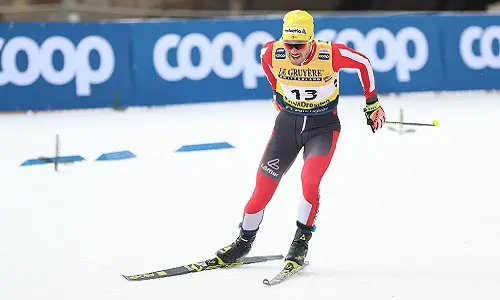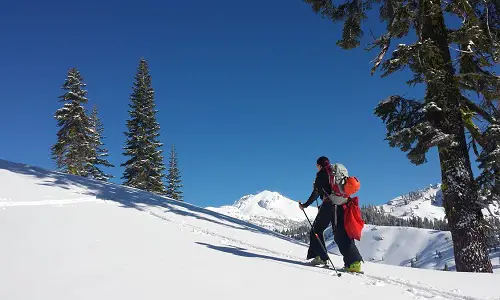Table of Contents
If you used to consider Nordic skiing and cross-country skiing as the same sport, you are not alone. Most people use these two terms interchangably as if they had the same meaning. Well, guess what – in a way they do, and in a way they do not! Confusing, right? Nordic and cross-country skiing may mean totally different things depending upon where you are skiing.
Nordic Skiing vs Cross-Country Skiing – What’s the Difference?
Nordic skiing could be any style of skiing that is done on ungroomed terrain, off the trails, and on mountains that are less steep, that is, primarily on snowfields. Cross-country skiing, on the contrary, is done on gentle, often groomed terrain containing parallel grooves that act as your skiing guides on the snow, eg. skate skiing, and classic stride, etc.
A Look Back on History
The evolution of skiing as a recreational and competitive sport is quite interesting. What started almost 5 thousand years ago as a means of transportation has now turned into a sport that drives thousands of people towards the snow.
What was once a necessity, soon started attracting people for recreational purposes. By the 1800s, nordic skiing was no longer just a means of transportation. In the Telemark region of Norway, Sondre Norheim presented the world with the first ski bindings.
In the 1930s, classic downhill skiing and nordic skiing were defined and differentiated on the basis of their ski bindings. What we have today is a more evolved version of nordic skiing, as nordic skiing has now been subdivided into different divisions as new and improved styles of nordic skiing started to emerge.
What is Nordic Skiing?
Nordic skiing is a style of skiing that is differentiated from alpine skiing in terms of how only the toe of the ski boot is attached to the binding, leaving the heels to rise freely using a free-heel binding system, thus enabling the skier to mimic walking or running. Nordic skiing can be done either on groomed trails or off-piste.
Nordic skiing has different disciplines, and the equipment and technique for those variations may greatly differ from each other. The Nordic skiing disciplines include:
- Cross-Country Skiing
- Telemark Skiing
- and Alpine Touring (AT)
Since all these types of nordic skiing belong to the same family, people and especially skiers often use these terms interchangeably. But that does not mean they are technically right!
Cross-country skiing is a form of nordic skiing, rather a variation of it, whereas the nordic skiing covers a couple of other disciplines under its umbrella.

Distinctions in Nordic Skiing
As mentioned above, the umbrella of nordic skiing covers many different sub-types of skiing. Let’s have a deeper look at those.
1. Cross-Country Skiing
The cross-country skiing is a form of Nordic skiing, but within XC skiing, there are some sub-categories as well, namely:
- Classic cross-country
- Skate skiing
- Light touring
The cross-country skiing is a very versatile form of skiing where you can enjoy the groomed terrain as well as the ungroomed one. This ability to ski on the track and then having the flexibility of going off-the-track attracts many skiers. However, do not go overboard with these as different styles of cross-country skiing may require slightly different skiing equipment.
If you ask a professional skier about what skiing style and equipment you should go for as a beginner, chances are he/ she would suggest you start with cross-country skiing, and specifically classic cross-country skis.
Classic vs Skate Skiing
Firstly, let’s discuss what are the differences between the two main styles of cross-country skiing that is classic and skate skiing. Check out our article on the matter then head back and get to know the other types of nordic skiing too.
Light Touring
The light touring cross-country skiing is more like an extension of classic skiing that is more adventurous as it takes the skiers to ungroomed off-piste terrain. If you have tried classic XC and want to go one step farther, going for light touring can be a great idea.
The light touring skis have free-heel bindings, just like classic skis, but the difference occurs in shape as these skies are relatively wider. Their wide shape gives the skier some additional support for gliding on the ungroomed territory.
The best part about the classic cross-country ski equipment used in light touring is that it is generally designed to be flexible enough to adapt both off-piste terrains as well as maintained tracks. Since the skis are versatile, it is therefore advised that skiers who go for light touring should stick to snowy parks and not extreme wild terrain when they are going off-piste.
2. Telemark Skiing
Telemark skiing is a Nordic skiing discipline which practically offers a crossover between cross-country skiing and alpine skiing. Similarly to cross-country skis, it has the free-heel binding system, however both the skis and boots are more similar to the large and rigid alpine skiing equipment. Telemark skiers are also able to traverse vertically.
If you want to know more about the distinction between cross-country and telemark skiing, check out our related article.

3. Alpine Touring
Alpine touring (abbreviated as AT) gives you the flexibility of touring some of the most picturesque backcountry terrains, and for this reason, it is quite famous among mountaineers.
In a way, the alpine touring skis are functionally similar to the Telemark skis. Both these types of skis are designed to go on ungroomed backcountry terrain as well as cover steeper downhill slopes. Like Telemark skis, the alpine touring skis are harder and stronger than cross-country skis, but lighter than Telemark skis – but the feature that makes them different is the heel system.
Technically, Alpine touring skis have a free heel binding system when you go uphill and lets you lock your heels while you go downhill. This makes them quite similar to the traditional downhill skis while considering their ski designs.
It is a common misconception among beginners that AT is only for advanced level skiers. In fact, alpine touring does not indicate a difficulty level – it is for all the skiers who have a certain energy level and the willingness to try out varying terrain. If you are passionate about walking in the snow, enjoying solitude in remote snowy locations, exploring untouched powdered snow, and doing cardio – alpine touring can be your thing.
Nordic Skiing Around the World
Now you know why people often interchange (and sometimes misunderstand) the terms for Nordic skiing and cross-country skiing. Although they may have some similarities as cross-country skiing comes under the umbrella of Nordic skiing, yet you may notice that there are many factors that differentiate the two.
If you have not tried both of them, it is better to start with cross-country skiing as a beginner. Most of the new skiers find cross-country skiing more welcoming as it uses your basic body mechanics to help you ski. Once you master your cross-country skiing (primarily classic cross-country), you can then move on to explore different types of cross-country skiing or Nordic skiing.
However, you will notice that the skiers use these two terms (Nordic skiing and cross-country skiing) quite different in the Alps (that touches eight alpine countries) as compared to in France. French may use the term “Ski Nordique” which means Nordic Skiing for skiing in areas considered as the Nordic areas – where the terrain is not steep.
No matter which part of the world you are and plan to ski in, one thing is for sure. Whether you plan to try out cross-country skiing for the first time as a beginner or want to explore different variants of Nordic Skiing – with the right equipment, skills, and enthusiasm, you can have a lot of fun on the snow-covered terrain. So, what are you waiting for?


